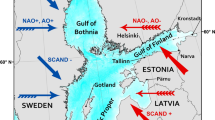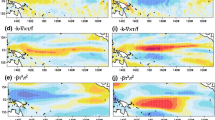Abstract
The large-scale extratropical circulation in the Southern Hemisphere is much more zonally symmetric than that of the Northern Hemisphere, but its zonal departures, albeit highly relevant for regional impacts, have been less studied. In this study we analyse the joint variability of the zonally asymmetric springtime stratospheric and tropospheric circulation using Complex Empirical Orthogonal Functions (cEOF) to characterise planetary waves of varying amplitude and phase. The leading cEOF represents variability of a zonal wave 1 in the stratosphere that correlates slightly with the Symmetric Southern Annular Mode (S-SAM). The second cEOF (cEOF2) is an alternative representation of the Pacific-South American modes. One phase of this cEOF is also very highly correlated with the Asymmetric SAM (A-SAM) in the troposphere. Springs with an active ENSO tend to lock the cEOF2 to a specific phase, but have no consistent impact on its magnitude. Furthermore, we find indications that the location of Pacific Sea Surface Temperature anomalies affect the phase of the cEOF2. As a result, the methodology proposed in this study provides a deeper understanding of the zonally asymmetric springtime extratropical SH circulation.














Similar content being viewed by others
Availability of data and materials
All data used in this paper available in a Zenodo repository (Campitelli et al 2022a) (https://zenodo.org/record/6612429). Indices updated monthly and daily will be made available at http://www.cima.fcen.uba.ar/~elio.campitelli/shceof/. It is also freely available from their respective sources: ERA5 data can be obtained via the Copernicus Climate Data Store (https://cds.climate.copernicus.eu/cdsapp/#!/dataset/reanalysis-era5-pressure-levels-monthly-means/). ERSSTv5 can be obtained via NOAA’s NCEI websiste at https://www.ncei.noaa.gov/access/metadata/landing-page/bin/iso?id=gov.noaa.ncdc:C00927 CMAP Precipitation data provided by the NOAA/OAR/ESRL PSL, Boulder, Colorado, USA, from their Web site at https://psl.noaa.gov/data/gridded/data.cmap.html. The Oceanic Niño Index is available via NOAA’s Climate Prediction Center: https://www.cpc.ncep.noaa.gov/products/analysis_monitoring/ensostuff/detrend.nino34.ascii.txt. The Oceanic Niño Index is available via NOAA’s Climate Prediction Center: https://www.cpc.ncep.noaa.gov/products/analysis_monitoring/ensostuff/detrend.nino34.ascii.txt. The Dipole Mode Index is available via Global Climate Observing System Working Group on Surface Pressure: https://psl.noaa.gov/gcos_wgsp/Timeseries/Data/dmi.had.long.data
References
Adams JC, Swartztrauber PN, Sweet R (1999) FISHPACK, a package of Fortran subprograms for the solution of separable elliptic partial differential equations. https://www2.cisl.ucar.edu/resources/legacy/fishpack
Albers S, Campitelli E (2020) Rsoi: import various northern and southern hemisphere climate indices
Allaire JJ, Xie [aut Y, cre, et al (2020) Rmarkdown: dynamic documents for R
Baldwin MP, Thompson DWJ (2009) A critical comparison of stratosphere-troposphere coupling indices. Q J R Meteorol Soc 135(644):1661–1672. https://doi.org/10.1002/qj.479
Bamston AG, Chelliah M, Goldenberg SB (1997) Documentation of a highly ENSO-related sst region in the equatorial pacific: Research note. Atmos Ocean 35(3):367–383. https://doi.org/10.1080/07055900.1997.9649597
Bell B, Hersbach H, Berrisford P, et al (2020) ERA5 monthly averaged data on pressure levels from 1950 to 1978 (preliminary version). Copernicus Climate Change Service (C3S) Climate Data Store (CDS) (Accessed on \(<\)26-08-2021\(>\)), https://cds.climate.copernicus.eu/cdsapp#!/dataset/reanalysis-era5-pressure-levels-monthly-means-preliminary-back-extension?tab=overview
Benjamini Y, Hochberg Y (1995) Controlling the false discovery rate: a practical and powerful approach to multiple testing. J Roy Stat Soc: Ser B (Methodol) 57(1):289–300. https://doi.org/10.1111/j.2517-6161.1995.tb02031.x
Cai W, Watterson IG (2002) Modes of interannual variability of the southern hemisphere circulation simulated by the CSIRO climate model. J Clim 15(10):1159–1174
Cai W, van Rensch P, Cowan T et al (2011) Teleconnection pathways of ENSO and the IOD and the mechanisms for impacts on Australian rainfall. J Clim 24(15):3910–3923. https://doi.org/10.1175/2011JCLI4129.1
Cai W, van Rensch P, Cowan T et al (2011) Teleconnection pathways of ENSO and the IOD and the mechanisms for impacts on Australian rainfall. J Clim 24(15):3910–3923. https://doi.org/10.1175/2011JCLI4129.1
Cai W, Sullivan A, Cowan T (2011) Interactions of ENSO, the IOD, and the SAM in CMIP3 Models. J Clim 24(6):1688–1704. https://doi.org/10.1175/2010JCLI3744.1
Cai W, McPhaden MJ, Grimm AM et al (2020) Climate impacts of the El Niño-Southern Oscillation on South America. Nat Rev Earth Enviro 1(4):215–231. https://doi.org/10.1038/s43017-020-0040-3
Campitelli E (2020) metR: tools for easier analysis of meteorological fields
Campitelli E, Díaz L, Vera C (2022a) Data for “Revisiting the Austral Spring Extratropical Southern Hemisphere zonally asymmetric circulation using complex Empirical Orthogonal Functions”. https://doi.org/10.5281/zenodo.6612324
Campitelli E, Díaz LB, Vera C (2022) Assessment of zonally symmetric and asymmetric components of the Southern Annular Mode using a novel approach. Clim Dyn 58(1):161–178. https://doi.org/10.1007/s00382-021-05896-5
Carvalho LMV, Jones C, Ambrizzi T (2005) Opposite phases of the antarctic oscillation and relationships with intraseasonal to interannual activity in the tropics during the Austral summer. J Clim 18(5):702–718. https://doi.org/10.1175/JCLI-3284.1
Cazes-Boezio G, Robertson AW, Mechoso CR (2003) Seasonal dependence of ENSO teleconnections over south America and relationships with precipitation in Uruguay. J Clim 16(8):1159–1176
Ciasto LM, Simpkins GR, England MH (2015) Teleconnections between tropical pacific SST anomalies and extratropical southern hemisphere climate. J Clim 28(1):56–65. https://doi.org/10.1175/JCLI-D-14-00438.1
Dowle M, Srinivasan A (2020) Data.table: Extension of ‘data.frame’
Fogt RL, Marshall GJ (2020) The Southern Annular Mode: Variability, trends, and climate impacts across the Southern Hemisphere. WIREs Clim Change 11(4):e652. https://doi.org/10.1002/wcc.652
Gelbrecht M, Boers N, Kurths J (2018) Phase coherence between precipitation in South America and Rossby waves. Sci Adv 4(12):3191. https://doi.org/10.1126/sciadv.aau3191
Gong D, Wang S (1999) Definition of antarctic oscillation index. Geophys Res Lett 26(4):459–462. https://doi.org/10.1029/1999GL900003
Goyal R, Jucker M, Gupta AS et al (2022) A new zonal wave 3 index for the Southern Hemisphere. J Clim 1:1–25
Grytsai A (2011) Planetary wave peculiarities in Antarctic ozone distribution during 1979–2008. Int J Remote Sens 32(11):3139–3151. https://doi.org/10.1080/01431161.2010.541518
Hartmann DL, Garcia RR (1979) A Mechanistic Model of Ozone Transport by Planetary Waves in the Stratosphere. J Atmos Sci 36(2):350–364
Hersbach H, Bell B, Berrisford P, et al (2019) ERA5 monthly averaged data on pressure levels from 1979 to present. Copernicus Climate Change Service (C3S) Climate Data Store (CDS) (Accessed on \(<\)13-03-2023\(>\)). https://doi.org/10.24381/cds.6860a573
Hobbs WR, Raphael MN (2010) Characterizing the zonally asymmetric component of the SH circulation. Clim Dyn 35(5):859–873. https://doi.org/10.1007/s00382-009-0663-z
Horel JD (1984) Complex principal component analysis: theory and examples. J Appl Meteorol Climatol 23(12):1660–1673
Hoskins BJ, Hodges KI (2005) A new perspective on southern hemisphere storm tracks. J Clim 18(20):4108–4129. https://doi.org/10.1175/JCLI3570.1
Huang B, Thorne PW, Banzon VF et al (2017) Extended reconstructed sea surface temperature, version 5 (ERSSTv5): upgrades, validations, and intercomparisons. J Clim 30(20):8179–8205. https://doi.org/10.1175/JCLI-D-16-0836.1
Hufkens K (2020) Ecmwfr: programmatic interface to the two European centre for medium-range weather forecasts API services
Irving D, Simmonds I (2015) A novel approach to diagnosing southern hemisphere planetary wave activity and its influence on regional climate variability. J Clim 28(23):9041–9057. https://doi.org/10.1175/JCLI-D-15-0287.1
Irving D, Simmonds I (2016) A new method for identifying the pacific-south american pattern and its influence on regional climate variability. J Clim 29(17):6109–6125. https://doi.org/10.1175/JCLI-D-15-0843.1
Kao HY, Yu JY (2009) contrasting eastern-pacific and central-pacific types of ENSO. J Clim 22(3):615–632. https://doi.org/10.1175/2008JCLI2309.1
Katz RW, Brown BG (1991) The problem of multiplicity in research on teleconnections. Int J Climatol 11(5):505–513. https://doi.org/10.1002/joc.3370110504
Kim Hk, Lee S (2004) The wave-zonal mean flow interaction in the Southern hemisphere. J Atmos Sci 61(9):1055–1067
Krokhin VV, Luxemburg WMJ (2007) Temperatures and precipitation totals over the Russian Far East and Eastern Siberia: Long-term variability and its links to teleconnection indices. Hydrol Earth Syst Sci 11(6):1831–1841. https://doi.org/10.5194/hess-11-1831-2007
L’Heureux ML, Thompson DWJ (2006) Observed relationships between the El Niño-Southern oscillation and the extratropical zonal-mean circulation. J Clim 19(2):276–287. https://doi.org/10.1175/JCLI3617.1
Lim EP, Hendon HH, Thompson DWJ (2018) Seasonal evolution of stratosphere-troposphere coupling in the southern hemisphere and implications for the predictability of surface climate. J Geophys Res Atmos 123(21):12002–12016. https://doi.org/10.1029/2018JD029321
Mo KC (2000) Relationships between low-frequency variability in the southern hemisphere and sea surface temperature anomalies. J Clim 13(20):3599–3610
Mo KC, Paegle JN (2001) The Pacific-South American modes and their downstream effects. Int J Climatol 21(10):1211–1229. https://doi.org/10.1002/joc.685
Nuncio M, Yuan X (2015) The influence of the indian ocean dipole on antarctic sea ice. J Clim 28(7):2682–2690. https://doi.org/10.1175/JCLI-D-14-00390.1
Pezza AB, Rashid HA, Simmonds I (2012) Climate links and recent extremes in antarctic sea ice, high-latitude cyclones, Southern Annular Mode and ENSO. Clim Dyn 38(1):57–73. https://doi.org/10.1007/s00382-011-1044-y
Plumb RA (1985) On the three-dimensional propagation of stationary waves. J Atmos Sci 42(3):217–229
R Core Team (2020) R: a language and environment for statistical computing. R Foundation for Statistical Computing, Vienna
Raphael M (2003) Recent, large-scale changes in the extratropical southern hemisphere atmospheric circulation. J Clim 16(17):2915–2924
Raphael MN (2004) A zonal wave 3 index for the Southern Hemisphere. Geophys Res Lett 31:23. https://doi.org/10.1029/2004GL020365
Raphael MN (2007) The influence of atmospheric zonal wave three on Antarctic sea ice variability. J Geophys Res Atmos 112:12. https://doi.org/10.1029/2006JD007852
Saji NH, Yamagata T (2003) Possible impacts of Indian Ocean Dipole mode events on global climate. Clim Res 25(2):151–169. https://doi.org/10.3354/cr025151
Saji NH, Goswami BN, Vinayachandran PN et al (1999) A dipole mode in the tropical Indian Ocean. Nature 401(6751):360–363. https://doi.org/10.1038/43854
Smith AK (1995) Numerical simulation of global variations of temperature, ozone, and trace species in the stratosphere. J Geophys Res Atmos 100(D1):1253–1269. https://doi.org/10.1029/94JD02395
Trenberth KE (1980) Planetary waves at 500 mb in the Southern hemisphere. Monthly Wea Rev 108(9):1378–1389
Trenberth KF, Mo KC (1985) Blocking in the southern hemisphere. Monthly Wea Rev 113(1):3–21
Turner J, Hosking JS, Bracegirdle TJ et al (2017) Variability and trends in the Southern Hemisphere high latitude, quasi-stationary planetary waves. Int J Climatol 37(5):2325–2336. https://doi.org/10.1002/joc.4848
van Loon H, Jenne RL (1972) The zonal harmonic standing waves in the southern hemisphere. J Geophys Res 77(6):992–1003. https://doi.org/10.1029/JC077i006p00992
Walker SGT (1914) Correlation in Seasonal Variations of Weather, III: On the Criterion for the Reality of Relationships Or Periodicities. Meteorological Office
Wickham H (2009) Ggplot2: elegant graphics for data analysis. Use R!, Springer-Verlag, New York, https://doi.org/10.1007/978-0-387-98141-3
Wilks D (2011) Statistical methods in the atmospheric sciences, vol 100. Elsevier, Amsterdam. https://doi.org/10.1016/B978-0-12-385022-5.00022-1
Wilks DS (2016) “The stippling shows statistically significant grid points’’: How research results are routinely overstated and overinterpreted, and what to do about it. Bull Am Meteor Soc 97(12):2263–2273. https://doi.org/10.1175/BAMS-D-15-00267.1
Wirth V (1993) Quasi-stationary planetary waves in total ozone and their correlation with lower stratospheric temperature. J Geophys Res Atmos 98(D5):8873–8882. https://doi.org/10.1029/92JD02820
Xie P, Arkin PA (1997) Global precipitation: a 17-year monthly analysis based on gauge observations, satellite estimates, and numerical model outputs. Bull Amer Meteor Soc 78 (Accessed on 26-08-2021)(11):2539–2558
Xie Y (2015) Dynamic documents with R and Knitr, 2nd edn. Chapman and Hall/CRC, Boca Raton
Yu JY, Paek H, Saltzman ES et al (2015) The early 1990s change in ENSO-PSA-SAM relationships and its impact on Southern Hemisphere climate. J Clim 28(23):9393–9408. https://doi.org/10.1175/JCLI-D-15-0335.1
Funding
The research was supported by UBACyT20020170100428BA, Consejo Nacional de Investigaciones Científicas y Técnicas (CONICET) PIP 11220200102038CO, PICT-2020-SERIEA-I-INVI-00540, and the CLIMAX Project funded by Belmont Forum/ANR-15-JCL/-0002-01. Elio Campitelli was supported by a PhD grant from CONICET, Argentina.
Author information
Authors and Affiliations
Contributions
EC made the data curation, formal analysis and prepared all the figures. EC and LD wrote the main manuscript text. All authors reviewed the manuscript.
Corresponding author
Ethics declarations
Conflict of interest
The authors have no relevant financial or non-financial interests to disclose.
Ethics approval
Not applicable.
Consent to participate
Not applicable.
Consent for publication
Not applicable.
Code availability
A version-controlled repository of the code used to create this analysis, including the code used to download the data can be found at https://github.com/eliocamp/shceof.
Additional information
Publisher's Note
Springer Nature remains neutral with regard to jurisdictional claims in published maps and institutional affiliations.
Rights and permissions
Springer Nature or its licensor (e.g. a society or other partner) holds exclusive rights to this article under a publishing agreement with the author(s) or other rightsholder(s); author self-archiving of the accepted manuscript version of this article is solely governed by the terms of such publishing agreement and applicable law.
About this article
Cite this article
Campitelli, E., Díaz, L.B. & Vera, C. Revisiting the zonally asymmetric extratropical circulation of the Southern Hemisphere spring using complex empirical orthogonal functions. Clim Dyn 61, 3989–4009 (2023). https://doi.org/10.1007/s00382-023-06780-0
Received:
Accepted:
Published:
Issue Date:
DOI: https://doi.org/10.1007/s00382-023-06780-0






